Tourist knots: types, application and knitting patterns

There are many varieties of knots, ranging from the simplest, which we use daily, tying shoelaces, to the most complex, used in mountaineering and sailing.
For a simple layman, and for an avid traveler, there is no need to know all the variations, it is enough to know the technique of knitting only the most basic knots.
What it is?
Tourist knot - a way of connecting ropes, ribbons and other dressings, which is based on their binding or interlacing. Knots used in tourism are subject to certain requirements: they must be simple both for remembering and for the method of tying, but at the same time reliable and also easy to untie if necessary.


Applications
Knots are an integral part of the life of a tourist, and their areas of application are quite diverse and depend on the conditions in which he finds himself, going on a regular hike or trip. But here is a list of possible uses for knots in travel:
- when building ropes;
- when setting up a tent;
- to overcome water barriers;
- for fixing objects;
- for fishing;
- when arranging days of rest and laundry (you need to arrange a rope for drying clothes);
- for descending from a height;
- when collecting firewood or brushwood for a fire;
- for insurance when moving in a group on mountainous terrain or weak ice, swamp.

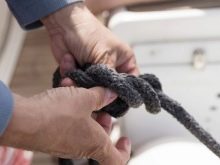

Kinds
There is no clear distinction between nodes for "marching" (tourist), "sea" and so on, since most of them are universal. Below are the most basic nodes with names and areas of their application.
- Straight (reef) - has been known since ancient times. In Ancient Greece and Ancient Rome existed under the name "Hercules". Serves for interlacing ropes with the same diameter. Control knots (controls) are necessary, since without them the knot easily slides.
- Eight (counter eight, Flemish knot) - Another representative of the ancient knots. It is necessary for reliable binding of various cargoes. Does not require additional controls when using.
- Bulin (arbor) - was used in ancient Egypt in the third millennium BC. It is used when tying around a support, interlacing two ropes, creating a non-tightening loop. When used during serious work (mooring, belaying, attaching a hook to a cable), control is necessary.
- Tent (simple bayonet) - serves to attach the tent cables to the pins. It also found its application in mooring ships, towing cars and lifting loads with hooks or winches. A distinctive feature is a non-tightening knot.
- Grapevine (Double Fisherman, Double English, Bloody) - used to tie two ropes of the same diameter. Differs in the increased fortress. After use, it is almost impossible to untie.
- Simple Explorer - used to organize a fulcrum on a rope, as well as to tie two ropes with a carabiner.After use, it is difficult to untie, knit only at the end.
- Average Austrian conductor - necessary to obtain a loop in the middle of the rope (third in a bunch, point, defect). Not used on ends.
- Double conductor, or "bunny ears" - needed for a rigid bundle of two ropes with each other. After application, it is almost impossible to untie.
- carabiner choke - serves for tying to a support, if after use the rope must be thrown off.
- Marking - serves to securely fasten the rope during its transportation.
- grasping - Allows the rope to lock into place in the event of an unexpected fall, such as a climber's fall while climbing.
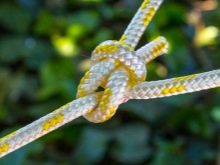


Knitting technique
Below is a detailed knitting pattern for the described knots.
Control node (control)
A well-known knot that is used everywhere. A loop is made from a single rope, into which the running end is inserted, after which the knot is tightened. The picture shows two knitting options using an additional rope.
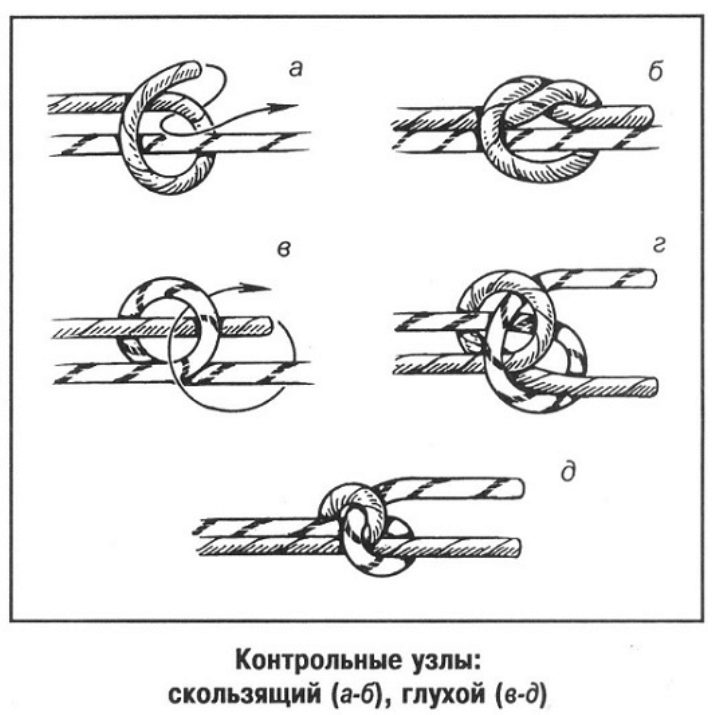
Straight (reef)
There are two ways to knit this knot.
- The first rope is folded into a loop. The second from above passes through its middle, then under one end, goes up, from above it goes under the opposite end and from the bottom through the middle comes back. The ropes are tightening.
- Both ropes are placed one on top of the other, after which it is necessary to tie two simple knots in opposite directions (figures c and d). In both options, it is important that the running ends are either at the bottom or at the top. Otherwise, the node will not come out.
Finally, you need to tie controls at the running ends to prevent the knot from spreading.
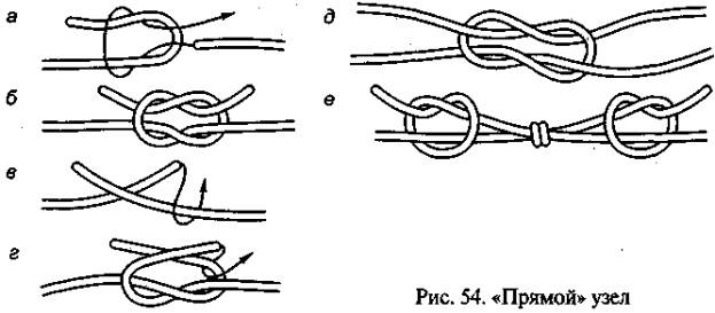
Eight
It will take one rope, fold it in half.The figure eight should be at the end. We fold the rope in this place in half again, put the end on top, then skip from the bottom, and then thread it into the loop formed and tighten. Control is not required.
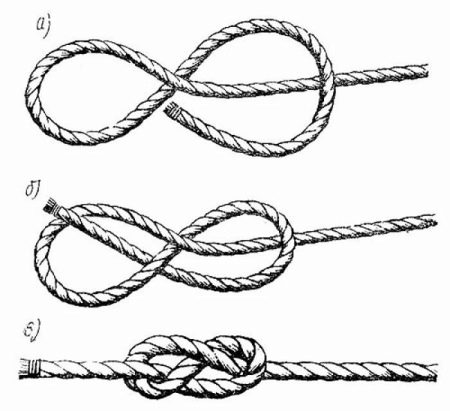
Bowline
There are two types of knitting. Both options require support.
- We estimate the required distance from the end of the rope, wrap the running end around the support and drag it through the loop made earlier, but do not tighten it yet. Next, we skip the end under the working rope and insert it into the loop again, but from the other end. Tighten and knit control.
- This option requires a "dummy", which is used instead of a loop. We fold the rope in half, wrap the resulting loop around the running end, and then thread it into the resulting hole. Then we surround the support with the running end and thread it through the “dummy” loop. Tighten and knit control.
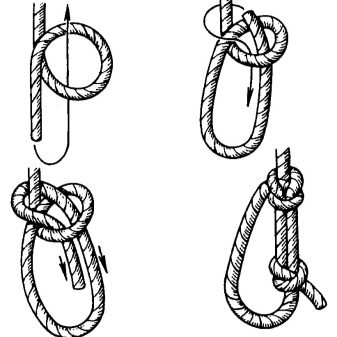

Tent (simple bayonet)
Support is also needed here:
- we throw the running end over the support;
- wrap it around the working part and insert the end into the resulting loop;
- repeat the previous operation. knit control.
The finished knot must be non-tight.

Grapevine
The knitting pattern is as follows.
- Two ropes of the same diameter are placed parallel to each other.
- There is a double control. To do this, we double-braid the second with the running end of one. First, the running end goes from above, then passes under the first rope, goes up - the first loop. The second one should be below. The running end again passes from above, then goes from below the first rope and goes up. At this stage, the loops are not tightened.
- After receiving two loops, the running end passes between the two ropes through both loops in the direction from the bottom up. The knot is tightened.
- A similar procedure occurs from the other end.
- Controls are not needed.

Simple Explorer
One rope is required. Fold it in half and knit a simple control knot. We tighten, and at the end of the running we knit a simple control.

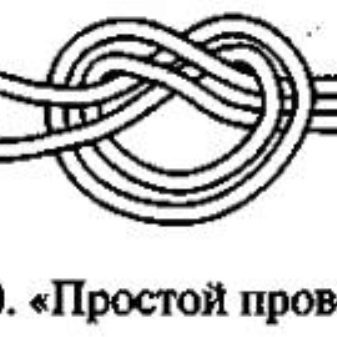
Middle Austrian conductor
Also, only one rope is needed. We find its middle, fold it in half and wrap it around its axis twice to get a figure eight that looks down. The lower loop is lifted and the first one is pulled through it, tightened. Control is not knitted.


Double conductor, or "hare ears"
You will need one rope. We fold it in half and make a loop, into which we thread the running end with the loop from below, but do not tighten it much. Should get a "dummy", unleashed, if you pull the loop, otherwise the knot will not be tied correctly.
After the “dummy” is ready, we carry the lower single loop through the double upper loop, for which we then tighten the knot. Control is not needed.
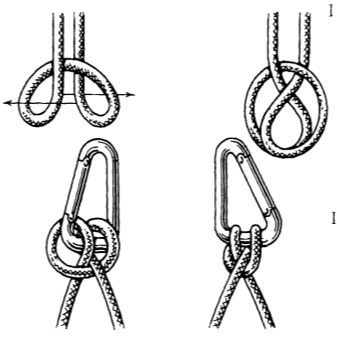
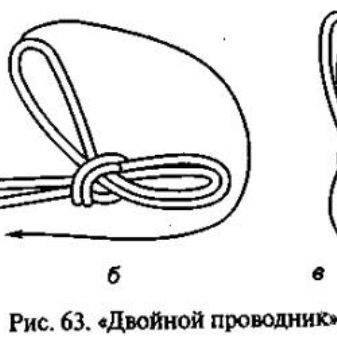
carabiner choke
One rope is required. At the end we knit the "eight", into which the carabiner is snapped. After we throw the working part around the support and snap the carabiner into this part. We twist the coupling, we tighten the knot.
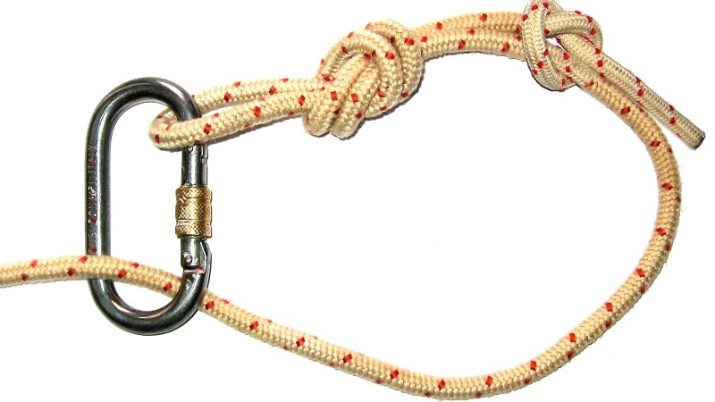
Marking
We take the skein to be knitted, and find its end, which will be running. We fold it in half, we get a loop. We wind the running end around our skein. The number of coils is arbitrary, but usually the width is equal to two diameters of the wrapped rope. After the running end is inserted into the previously made loop. The knot is tightened, the control does not fit.
There is another variation that makes it easier to untie the resulting knot. To do this, after winding, the running end is folded in half and threaded through the loop. In this case, tightening occurs for the main part, and not for the working end. Control is not needed.
The picture shows an option when both running ends are used.

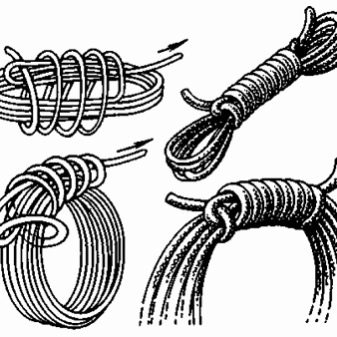
grasping
There are two ways to knit, both will require two ropes. Thick, which will be the main one, and the cord, as a rule, is twice as thin as it.
- Fold the cord in half and wrap around the main rope. We pass the running ends of the cord into the loop formed. We repeat these operations again. We tighten the knot, straighten it and tie the control. You can do without control if you previously tied a “grapevine” on the cord.
- Knitted with one running end of the cord. The main rope is first wrapped around it twice to the left from the place where the cord was attached, then it is transferred to the right and wraps around the rope again, but already to the place of application. The knot is tightened, control is knitted.
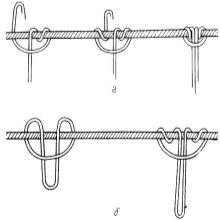
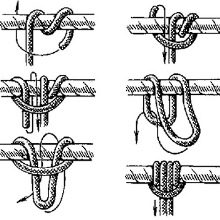

For information on how to knit tourist knots, see the following video.




























